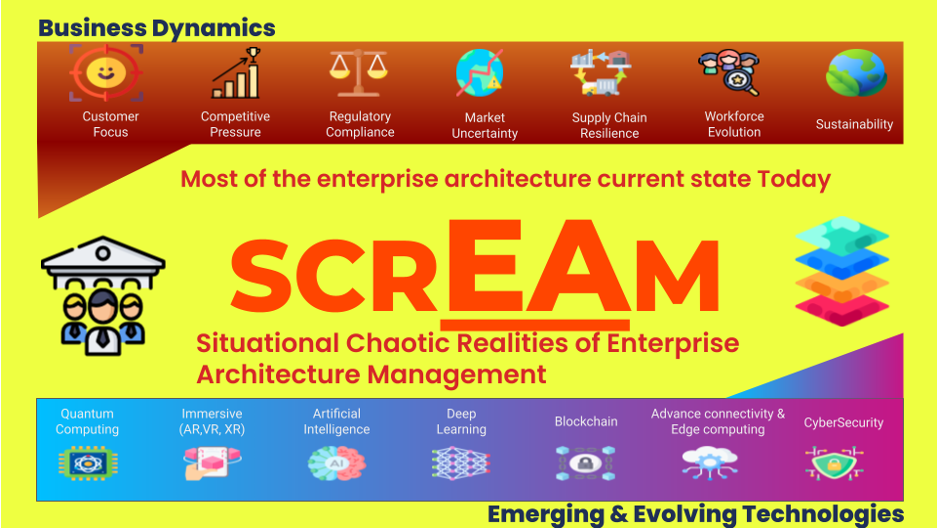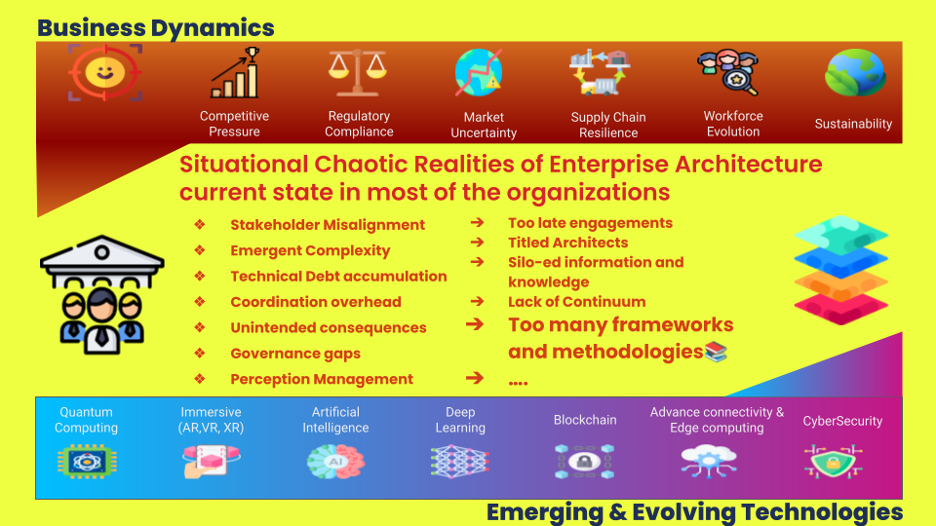
(Editor’s Note; This article represents part two on an article that appeared on August 18, entitled “The Unavoidable ‘SCREAM’: Why Enterprise Architecture Must Transform for the Organization of Tomorrow“, which detailed the current state of chaotic SCREAM.)
Enterprise architecture (EA) is caught in a maelstrom. The promise of strategic alignment and thoughtful design is constantly challenged by business dynamics, emerging and evolving technologies, and vendors’ strategic promotion of capabilities through conferences and connections.
EA, supposedly the central nervous system of an enterprise, is mostly nervous or on edge—hardly central, and given the current dynamics of AI, it’s becoming neurotic.

SCREAM- Situational Chaotic Realities of Enterprise Architecture Management- captures the current state of EA practice, where most organizations, from medium to large complexity, struggle to derive optimal value from investments in enterprise architecture capabilities. It’s the persistent legacy challenges across technology stacks and ecosystems that need to be solved to meet strategic business goals and those moments when sudden, ill-defined executive needs are met with a hasty, reactive sprint, leading to a fractured and ultimately paralyzing effect on the entire organization. And of course, stability and longevity of Enterprise Architecture as a functional group / organization itself (dead or alive). Most importantly, the paradox of abundant EA frameworks and elusive effectiveness. The chaos of SCREAM is the reality for practicing architects, fueled by a perfect storm of external and internal pressures.
The Dynamic Business Landscape
Today’s organizations navigate a relentless barrage of challenges demanding immediate—and often conflicting—responses, from hyper-personalized customer experiences and fierce competition from technology-enabled new entrants, to relentless regulatory compliance battles and changing workforce expectations. Add geopolitical supply chain disruptions and sustainability imperatives, and you have converging forces each demanding immediate architectural responses. These dynamics create immense strain on architectural practice, especially when organizations are caught unaware—common for those scrambling to catch up or suddenly elevated in vendor priorities. The result is architectural chaos.
The Technology Tsunami
At the same time, the way technology is moving—and moving so rapidly—there is no actual time to take a breath and think holistically and strategically. There are many articles and reports that validate that EA is being “profoundly reshaped by emerging technologies such as Artificial Intelligence (AI), cloud-native architectures, the Internet of Things (IoT), and blockchain”.
A 2025 MIT report reveals that 95% of generative AI pilots fail to deliver measurable financial impact, often due to flawed integration with existing architectures, exacerbating SCREAM’s chaos through silos and compatibility issues.
The paradox is that the very technologies offering solutions to business challenges are also key sources of architectural chaos, further entrenching reactive SCREAM. As noted, the inevitable chaos and fragmentation that emerge from continuous technology additions lead to silos and escalating compatibility issues.

The Internal and key challenges: A Storm in the EA Cupboard
The chaos of SCREAM is not just an external force; it’s a product of our own making. While we preach alignment to the business, we often get caught up in our own storm in an EA cupboard. How often do we play EA on EA?
If only we could have more business centricity and be able to manage challenges in the technology realm from framework, tools, operating model, sponsorship, skillsets, role etc.
Stakeholder Misalignment: This represents a persistent and significant challenge. It’s the classic disconnect where technical teams and business leaders speak different languages, leading to a fundamental lack of business buy-in and creating a pervasive, long-standing organizational challenge. The real barrier is not vocabulary, but a lack of shared intent that is clearly understood by all parties.
The Afterthought Architect: The lack of business buy-in, executive sponsorship, and departmental engagement creates a major hurdle. This reactive role, where architects are brought in to “clean up the mess or rubber stamp,” drains resources and diminishes EA’s value, as enterprise architects become overwhelmed with reactive or solutioning work rather than strategic planning.
Insufficient & Siloed Knowledge: The absence of interconnected or central EA repositories leads to siloed information existing only in the minds of a few key individuals, making proactive work nearly impossible. This problem feeds into the “anarchy” that arises when independent teams opt for custom solutions. The lack of enterprise continuum results in siloed architecture work focused on creating diagrams and visuals rather than driving business value. This is not about needing heavy documentation focus.
Framework Fatigue: Architects find themselves trapped in constant debates over methodologies. Multiple reports and articles address how blindly adopting frameworks can lead to “endless workshops, committee paralysis, and framework obsession over actual business delivery.”. Existing EA frameworks are often perceived as too theoretical and vast, making them difficult for practicing architects to comprehend and implement effectively. These learning curves and extended time-to-value further hinder framework adoption. From a former federal CIO calling frameworks “useless” to a ResearchGate publication about “frameworks being fad of the century”, this is definitely one of the must solve challenges
Failure to show value-add – While pockets of recognizable EA wins may exist through effective engagement, a true, repeatable value-add requires a seat at the strategic table. This means “architecture-first” must evolve beyond being a mere buzzword or a token effort, becoming a reliable approach that promotes collaborative success rather than individual credit-grabbing.
The current state of SCREAM is a reality that many architects face, but it is not our destiny. The path forward requires strategic conversion of realities and building a new, desired state for every organization- AARAM: Adaptive, Agile, Resilient Architecture Management
